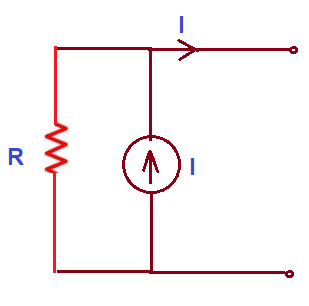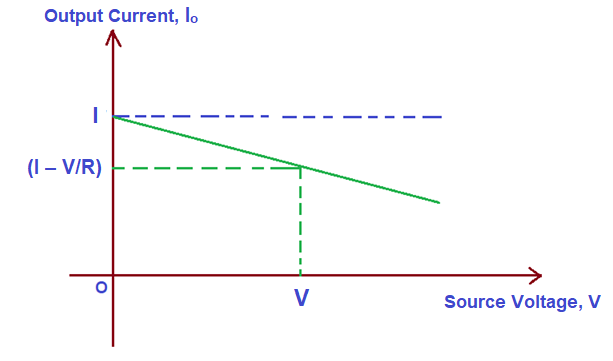Ideal Current Source:
Definition:
An ideal current source is a two terminal device which supplies constant current irrespective of load resistance. The value of current will be constant with respect to time and load resistance. This means that the power delivering capability is infinite for this source.
An ideal current source has infinite parallel resistance connected to it. Therefore, the output current is independent of voltage of the source terminals. No such current source exists in the world, this is just a concept. However, every current source is designed to approach closer to the ideal one.
Symbol:
It is represented by the symbol as shown below.

Characteristics:
The characteristics of ideal current source is shown below.

Internal Resistance of Ideal Current Source:
The internal resistance of current source is the value of resistance connected across its terminal. This internal resistance of ideal current source is infinite.
Let us understand this using circuit diagram. Any current source is represented by a parallel connection of current source and resistance. This is shown in figure below.

Since, output current in the above circuit should be I for ideal case, this means the current through parallel resistance R should be zero. This is only possible if the value of this resistance is infinite. This is the reason; the internal parallel resistance of ideal current source is infinite.
Practical Current Source:
Definition:
A practical current source is a two terminal device having some resistance connected across its terminals. Unlike ideal current source, the output current of practical source depends on the voltage of the source. The more this voltage, the lesser will be the current.
To better understand, let us consider a practical current source as shown below.

It is quite clear from the above circuit that the voltage of source is equal to the voltage drop across the resistance R. This voltage drop is given as V = iR, where i is the current through the resistance R. Hence the output current Io = (I – i).
Thus, if V is more, this means i is more and hence output current Io will be less.
Characteristics of Practice Current Source:
Let us first derive the relationship between the voltage of the source and output current.
V = iR
i = V/R
Therefore,
Io = (I – i)
= (I – V/R)
The above equation represents a straight line with slope (-1/R). Thus, the characteristics of practical current source can be drawn as shown below.

Hope you enjoyed the article. Kindly write in comment box for any suggestion / value addition.
Give some example as well